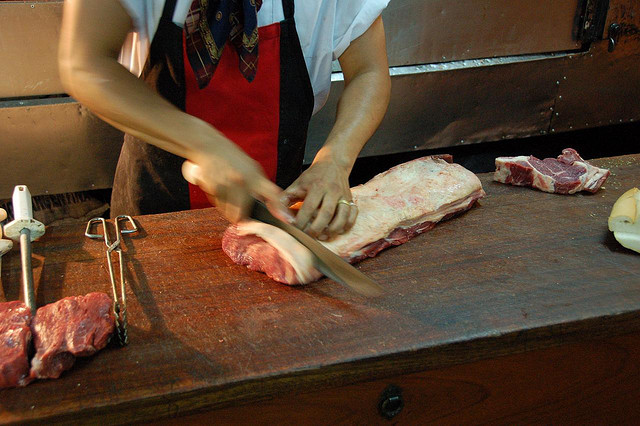Visitors to Buenos Aires looking for great steak often immediately seek out the local equivalent to the filet mignon, known as the bife de lomo. It is tender and succulent, and worth every penny, but truth be told, it is rarely first choice for Argentines meeting for their weekly quota of grilled beef. More often than not, they fill up on bife de chorizo.
Literally translated as the Sausage Steak, the bife de chorizo is cut from the short loin area and is known in the United States as strip steak or New York strip. It is usually cut into steaks that are about 5 centimetres thick and 15 centimetres lengthwise (vaguely resembling a sausage, hence the name) and each steak can easily feed one person. The meat is sparsely marbled but is lined on one side with a thick layer of fat that cooks into the meat when grilled properly. Because the muscle that the bife de chorizo is cut from is worked to a greater extent than the neighbouring bife de lomo, it is less tender and more fibrous, but this is matched by a much greater intensity of flavor. When I describe these two cuts to people who ask me for recommendations, I describe the lomo as delicate and tender, and the bife de chorizo as the option for those seeking to actually taste some beef. The bife de chorizo in that sense is the big bully when compared to the lomo, as it’s bigger, more intense and not as much as a pushover. Quick note on wine and this cut – this is precisely the cut of beef that screams out for a Malbec with a full body.
On the grill, bife de chorizo does best when cooked medium-rare, as the outer layer of fat needs a bit of heat to melt into the meat and the thickness of the steaks means that sometimes when cooked rare the steak can be quite bloody at the heart of the cut. Anytime that it is cooked medium and further you risk a steak that is chewier than you might enjoy. Unless you prefer your meat cooked all the way, it can be quite the letdown to get a bife de chorizo in that state.
Although uncommon and it requires the presence of group of hungry friends, it is possible to grill the bife de chorizo whole, that is, to grill the entire piece that the butcher cuts the individual steaks from. This is difficult, because at this point you have a hunk of meat weighing at least 2 kilograms and the trick is to get the entire piece cooked evenly to the desired point. The thick outer layer of fat is prone to catching fire while sitting on the grill (in Argentina, the sight of flames licking the meat is terrifying enough to make the toughest gaucho cry. Flames should never touch any meat.) and it requires considerable more attention and fretting than a few steaks on the grill. The benefits though are worth it. As you have a limited surface area exposed to the heat, there is a reduction juice run off and hence a more flavourful steak. Furthermore, there is something quite special about cutting a perfectly cooked steak out of a 2.5 kilogram hunk of of meat. Anyone who enjoys carving turkey needs to try it, if only once.
Even more challenging is to grill a whole piece of bife de chorizo with the bone in. The key difference with leaving the bone in is that it adds even further flavor to the meat, but it also complicates things by making carving more difficult and more importantly, by adding an extra element for the parrillero to be aware of. Bone takes longer to heat up than meat does, but once it’s hot, it radiates heat and helps to cook the surrounding meat. Keeping that extra element in mind is absolutely necessary if you are going to serve an evenly cooked piece of bife de chorizo.
So, take a page out of the Argentine approach to beef and consider the bife de chorizo as a worthy alternative when out to soothe a beef craving. It will require more work than the lomo, but you will find its absolutely worth it.


